Year delivered 1897 Recipient Alexandra Fyodorovna | Customer Nicholas II Year of acquisition 2004 | |
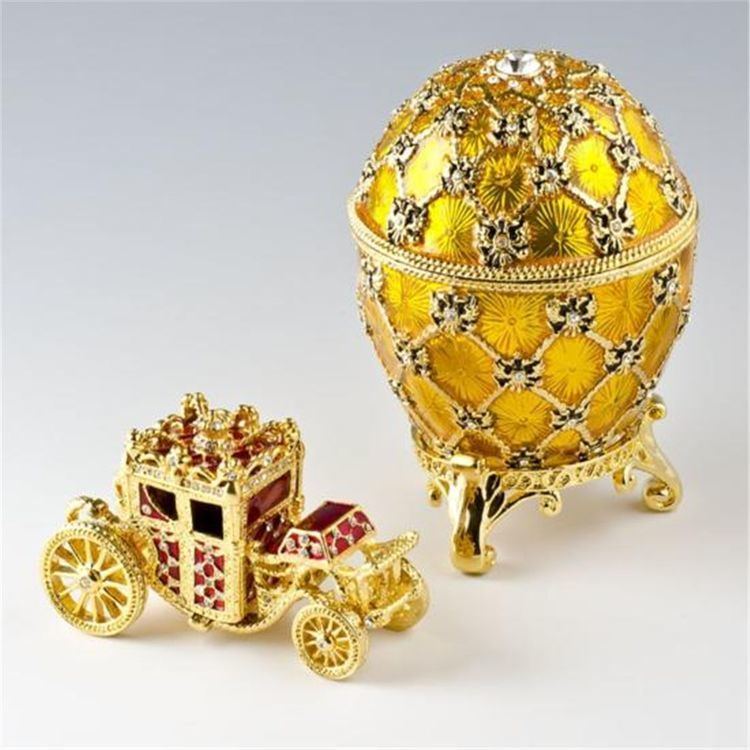 | ||
Individual or institution Fabergé Museum in Saint Petersburg, Russia Workmaster Michael Perkhin, Henrik Wigström Similar Romanov Tercentenary, Pelican, Rock Crystal, Rosebud, First Hen Egg | ||
The imperial coronation egg
The Imperial Coronation Egg is a jewelled Fabergé egg made under the supervision of the Russian jeweller Peter Carl Fabergé in 1897 by Fabergé ateliers, Mikhail Perkhin and Henrik Wigstrom. The egg was made to commemorate Tsaritsa, Empress Alexandra Fyodorovna.
Contents
- The imperial coronation egg
- Craftsmanship
- Surprise
- History
- Royal origin
- Further transactions
- Late twentieth century
- Representation in film
- References
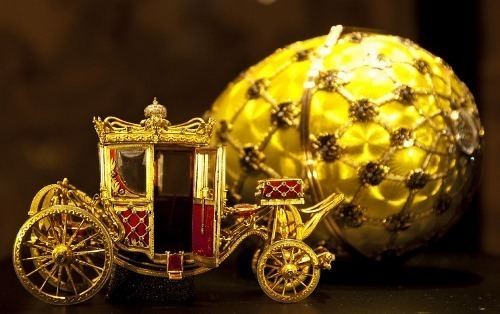
It was frequently on exhibition at The Hermitage Museum (specifically the Winter Palace) in St. Petersburg, Russia, and also materialized in various museums worldwide, placed in temporary exhibits there. It is currently owned by one of the Russian oligarchs, Viktor Vekselberg.
Craftsmanship
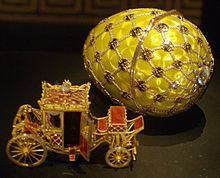
The egg is made from gold with translucent lime yellow enamel on a guilloché field of starbursts and is in reference to the cloth-of-gold robe worn by the Tsarina at her Coronation.
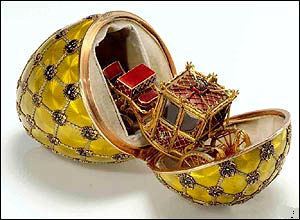
It is trellised with bands of greenish gold laurel leaves mounted at each intersection by a gold Imperial double-headed eagle enamelled opaque black, and set with a rose diamond on its chest. This pattern was also drawn from the Coronation robe worn by the Empress.

A large portrait diamond is set in the top of the egg within a cluster of ten brilliant diamonds; through the table of this stone, the monogram of the Empress can be seen. At the other, more narrow end, a smaller portrait diamond is set within a cluster of rose diamonds surrounded by a flower motif made of 20 narrow gold petals. At this end of the egg the portrait diamond covers the date 1897 inscribed on a plaque similar to that of the monogram. The egg was presented together with a glass-enclosed jadeite stand for the display of the carriage at a cost of 5650 rubles.
Surprise
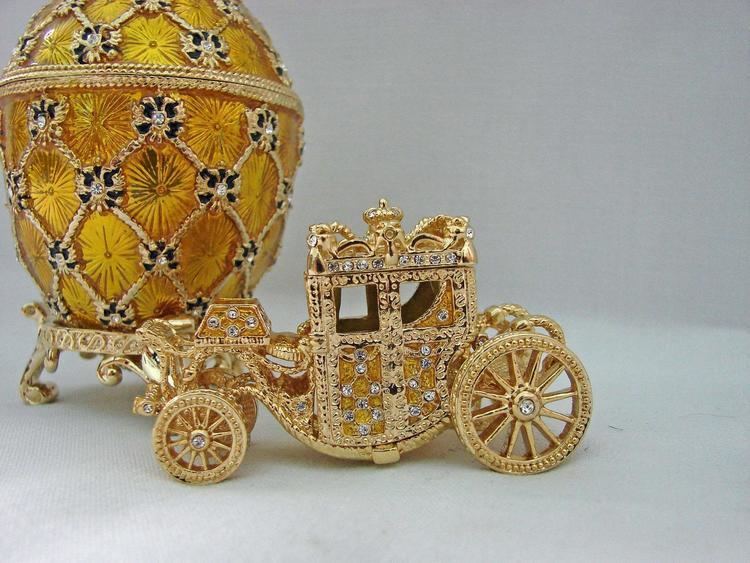
Fitted inside a velvet-lined compartment is a precise replica, less than four inches long, of the Eighteenth-century Imperial coach that carried the Tsarina Alexandra to her coronation at Moscow's Uspensky Cathedral.
The red colour of the original coach was recreated using strawberry coloured translucent enamel and the blue upholstery of the interior was also reproduced in enamels. The coach is surmounted by the Imperial Crown in rose diamonds and six double-headed eagles on the roof; it is fitted with engraved rock crystal windows and platinum tyres decorated with a diamond-set trellis in gold and an Imperial eagle in diamonds at either door. The miniature is complete with moving wheels, opening doors, actual C-spring shock absorbers and a tiny folding step-stair.
Missing surprises include an emerald or diamond pendant that hung inside the replica coach, a glass-enclosed jadeite stand for the display of the carriage as well as a stand made of silver-gilt wire.
History
The Coronation of Tsar Nicholas II and his spouse, Empress Alexandra Fyodorovna was the catalyst for the Imperial Coronation Egg's creation, to celebrate the historical event. The Coronation on May 14, 1896, was a day of jubilance and pride in the Romanovs, celebrated by throngs of spectators. The Russian nobles and guests gathered on the Eastern Orthodox day of Dormition, the death of Mary, inside Uspensky Cathedral for the actual Coronation. The throne of the Czar, the former throne of Michael I of Russia was inset with 870 diamonds, rubies, and pearls. The throne of the Tsarina, the famous ivory throne of Ivan the Great, also was inset with a vast collection of jewels and rare gemstones.
The gold miniature coach, which is removable from the interior of the Coronation Egg, is a replica of Catherine the Great's Gold Coach of 1793 used to transport the last Romanov rulers from ceremony to ceremony on the coronation week. Another artifact used in the coronation from the reign of Catherine was the Imperial Crown of Russia diamond crown made by Jérémie Pauzié in 1762.
Royal origin
The Egg was first given to Tsarina Alexandra of Imperial Russia on Easter of 1897. The egg was displayed in the Empress' apartment at the Winter Palace in St. Petersburg, resting in a jewelled carriage. Upon the fall of the Romanov Dynasty, the egg was confiscated by the Provisional Government in 1917 and was listed among the treasures removed from the Anichkov Palace. It was then dispatched to the Kremlin and finally transferred to the Sovnarkom in 1922 for sale.
Further transactions
During the Famine of 1921, a wealthy American business magnate, Armand Hammer, recovered many works of art and priceless antiques that would have been lost in the political upheaval of the Russian Revolution. Hammer, through negotiations, was able to purchase 11 of the Fabergé Eggs, but the Coronation Egg was not among those purchased or sold by Hammer. Instead, it was purchased in 1927 by Emanuel Snowman for Wartski a family-owned firm of art and antique dealers in London. The egg was then sold to the collector Charles Parsons in 1934, but then reacquired by Wartski in 1945 and remained with the company until early 1979.
Late twentieth century
In March 1979 the egg was sold to Malcolm Forbes for $2.16 Million USD along with the Lilies of the Valley Fabergé Egg.
In 2004 9 Fabergé eggs, including the Imperial Coronation Egg, were to be sold by Sotheby's Auction House, however on February 4, 2004, Sotheby's announced that more than 180 Fabergé art pieces, including the 9 rare Fabergé eggs, had been withdrawn from auction and privately sold to Viktor Vekselberg. The official selling price of the Coronation Egg to Vekselberg was never publicly disclosed by Sotheby's, fueling much speculation. However, CNN reported the day after the sale that "...it was a very serious offer that the Forbes family accepted." In a 2013 BBC Four documentary, Vekselberg revealed he had spent just over $100 Million purchasing the 9 Fabergé eggs.
Representation in film
An accurate model of the Imperial Coronation Egg was depicted in the 2004 crime film Ocean's Twelve. The replica was produced by design studio Vivian Alexander, popular for recreating famous items of jewelry for public and private purposes. The replica is worth approximately $4,000 USD. In the film, the egg was stolen in a grand heist from a museum in Rome by the notorious Ocean's Twelve.
The James Bond film, Octopussy (1983), encompasses the mysterious appearance of a fabricated Coronation Egg at a party in the British Embassy of West Berlin. The plot for the film is adapted from Ian Fleming's 1963 short story "The Property of a Lady".
